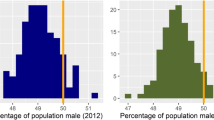Abstract
In parts of the circumpolar North, smaller communities tend to have fewer young women than men. Among newcomer populations such as non-Natives in Alaska, this reflects disproportionate in-migration by young men seeking jobs on the frontier. Imbalances can also emerge, however, due to female outmigration from small villages—a pattern observed, for example, among the native populations of Alaska, Canada and Greenland. Several authors have linked female outmigration with socioeconomic change also in rural Finland, Norway and Ireland. This paper briefly examines plots of sex ratio versus community size in four northern Atlantic regions (Maine, Newfoundland, Iceland and Norway). We then look more closely at Norway, where the correlation between sex ratio and community size is strongest. Multiple regression suggests that economic factors, rather than community size as such, best explain this pattern. Specifically, the percent female among young adults tends to be lower in communities experiencing longterm population declines, dominated by fishing and other primary-industry employment, and having in consequence relatively few jobs for women. Further socioeconomic changes in many resource-dependent Atlantic communities seem inevitable as resources become depleted, and they also face the possibility of large-scale environmental change. When such changes occur, female outmigration could be an important component of the social response and individual-level adaption.
Similar content being viewed by others
REFERENCES
Chance, N. A. (1990). The Inupiat and Arctic Alaska: An ethnography of development. Fort Worth: Holt, Rinehart and Winston.
Flanders, N. E., Enequist, F. and Young, O. (1995). Alternatives to the West Greenland Atlantic salmon fishery. Hanover, NH: Dartmouth College, Dickey Center Institute of Arctic Studies.
Flanders, N. E., Hamilton, L. C. & Duncan, C. M. (1995). Northern Atlantic fisheries: Large scale processes and human communities. Paper presented at the International Congress of Arctic Social Sciences, Rovaniemi, Finland 31 May.
Fogel-Chance, N. (1993). Living in both worlds: “Modernity” and “tradition” among North Slope Inupiat women in Anchorage. Arctic Anthropology 30(1), 94–108.
Graburn, N. H. H. (1982). Television and the Canadian Inuit. Etudes/Inuit/Studies 6(1), 7–17.
Gugler, J. (1994). The gender transition in rural-urban migration. Paper presented at the International Sociological Association.
Hamilton, L. C. (1992). Regression with graphics. Belmont, CA: Duxbury.
Hamilton, L. C., Rasmussen, R. O., Flanders, N. E. & Seyfrit, C. L. (1996). Outmigration and gender balance in Greenland. Arctic Anthropology.
Hamilton, L. C., & Seyfrit, C. L. (1993a). Town-village contrasts in Alaskan youth aspirations. Arctic 46(3):255–263.
Hamilton, L. C., & Seyfrit, C. L. (1993b). Female flight? Gender balance and outmigration by Native Alaskan villagers. Arctic Medical Research 53(Supplement 2), 189–193.
Hamilton, L. C., & Seyfrit, C. L. (1994). Coming out of the country: community size and gender balance among Alaskan Natives. Arctic Anthropology 31(1), 16–25.
Hamilton, L. C., Seyfrit, C. L., & Bellinger, C. (1997). Environment and gender balance among Alaska Natives: An historical perspective. Population and Environment 18(3), 283–300.
Hannan, D. (1988). Irish rural-urban migration: Post 1960 changes. Paper presented at the Rural Sociological Society.
Jentoft, S. (1993). Dangling lines: The fisheries crisis and the future of coastal communities. St. John's Newfoundland: Institute of Social and Economic Research, Memorial University of Newfoundland.
Jorgensen, J. G. (1990). Oil age Eskimos. Berkeley: University of California Press.
Kochmer, J. P. & Johnson, D. R. (1995). Demograph and socioeconomics of northern North America: Current status and impacts of climate change. In Peterson and Johnson (Eds.). Human ecology and climate change: People and resources in the Far North, pp. 31–54. Washington, DC: Taylor and Francis.
Langgaard, P. (1986). Modernization and traditional interpersonal relations in a small Greenlandic community: A case study from southern Greenland. Arctic Anthropology 23(1–2), 299–314.
Masini, Eleonora & Stratigos, Susan (Eds.) (1991). Women, households and change. Tokyo: United Nations University Press.
Messenger, J. C. (1969). Inis Beag, Isle of Ireland. New York: Holt, Rinehart and Winston.
Pedraza, Silvia (1991). Women and migration: The social consequences of gender. Annual Review of Sociology 1991 17, 303–325.
Pelto, P. J. (1973). The snowmobile revolution: Technology and social change in the Arctic. Menlo Park, CA: Cummings.
Robert-Lamblin, J. (1982). An historical and contemporary demography of Akutan, an Aleutian village. Etudes/Inuit/Studies 6(1), 99–126.
Scheper-Hughes, N. (1979). Saints, scholars, and schizophrenics: Mental illness in rural Ireland. Berkeley: University of California Press.
Stenbaek, M. (1987). Forty years of cultural change among the Inuit in Alaska, Canada and Greenland: Some reflections. Arctic 40(4), 300–309.
Sztokman, N. (1983) Les femmes dans la migration regionale en France. Etudes-Migrations 20(70), 205–213.
Taylor, K.I. (1966). A demographic study of Karluk, Kodiak Island, Alaska, 1962–1964. Arctic Anthropology 3(2), 211–239.
United Nations Department for Economic and Social Information and Policy Analysis, Population Divison (1990). International migration policies and the status of female migrants. New York: United Nations.
Author information
Authors and Affiliations
Rights and permissions
About this article
Cite this article
Hamilton, L.C., Otterstad, O. Sex Ratio and Community Size: Notes from the Northern Atlantic. Population and Environment 20, 11–22 (1998). https://doi.org/10.1023/A:1023347817418
Issue Date:
DOI: https://doi.org/10.1023/A:1023347817418




